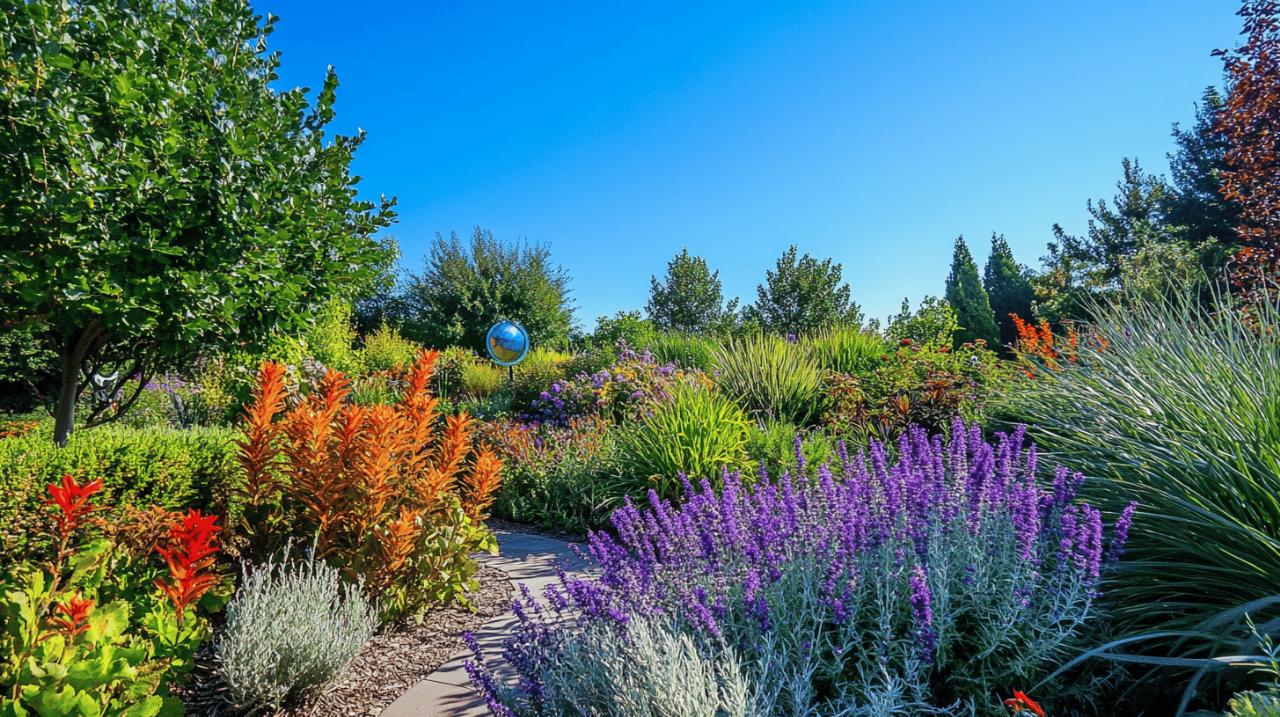Creating a beautiful garden doesn't have to mean endless hours of watering and maintenance. By choosing drought-resistant plants, you can enjoy a vibrant outdoor space that thrives even during dry spells. These water-wise selections are perfect for busy gardeners or those looking to create more sustainable landscapes that conserve resources while still delivering visual impact.
Understanding drought-resistant gardening
Drought-resistant gardening is all about working with nature rather than against it. Casa Jedo experts recommend this approach as it combines beauty with practicality, creating landscapes that remain attractive with minimal intervention. This gardening philosophy has gained popularity as climate patterns change and water conservation becomes increasingly important for responsible homeowners.
What makes plants drought-tolerant
Drought-tolerant plants have evolved special adaptations that allow them to survive in arid conditions. Many feature deep root systems that can access water far below the surface, while others have developed waxy, silvery, or hairy foliage that reflects sunlight and reduces moisture loss. Succulents store water in their fleshy leaves and stems, allowing them to thrive for extended periods without rainfall. These natural adaptations mean these plants require significantly less maintenance than traditional garden varieties.
Benefits of a water-wise garden design
A garden filled with drought-resistant plants offers numerous advantages beyond water conservation. These landscapes typically require less overall maintenance, saving you time on watering, fertilizing, and other garden chores. They tend to be more resilient against extreme weather conditions and often attract beneficial pollinators. Additionally, water-wise gardens can reduce your utility bills while still providing year-round visual interest through carefully selected plant combinations that offer diverse textures, heights, and seasonal displays.
Top succulents for your low-maintenance landscape
Succulents form the backbone of many drought-resistant gardens, offering architectural interest and unique forms that create striking visual statements with minimal care requirements. These plants thrive in well-draining soil and sunny positions, making them perfect for challenging garden spots where other plants might struggle.
Architectural statement succulents
For dramatic impact, consider incorporating Cotyledon orbiculata, which features fleshy, powder-blue leaves and charming bell-shaped flowers. This impressive succulent can reach heights of 1.3 meters with a spread of 60cm, though it's best grown in containers in colder regions so it can be brought indoors during winter. Sedums (now often classified as Hylotelephium) are another excellent choice, forming neat mounds of succulent foliage crowned with pink, ruby, or white flower clusters that reach about 60cm in height and spread, attracting butterflies and bees during their late-summer blooming period.
Colorful succulent varieties for visual interest
Drought-tolerant gardens need not lack color. Many succulents offer vibrant hues that enliven the landscape throughout the seasons. Varieties with contrasting foliage colors create visual interest even when not in bloom. For container gardens, combining different succulent types with complementary colors and textures creates living sculptures that evolve throughout the year. The low-growing nature of many varieties makes them excellent choices for edging pathways or filling gaps between larger drought-resistant specimens.
Mediterranean herbs that thrive in dry conditions
Mediterranean herbs have evolved in hot, dry climates, making them naturally adapted to drought conditions. These aromatic plants not only conserve water but also bring wonderful fragrances and culinary uses to your garden space. Their silver-gray foliage often adds a distinctive texture to garden designs.
Culinary herbs that need minimal watering
Rosemary stands out as one of the most drought-tolerant culinary herbs, with its woody stems and needle-like leaves that contain aromatic oils. Lavender varieties offer beautiful purple blooms along with their distinctive scent, thriving in poor, dry soils where many other plants would fail. These herbs require well-draining soil and plenty of sunshine to develop their full flavor profiles. Once established, they need very little supplemental watering, making them perfect additions to low-maintenance garden designs near kitchen areas.
Creating a fragrant drought-resistant herb garden
A dedicated herb garden combining various Mediterranean varieties creates a sensory experience while remaining water-wise. Thyme, oregano, and sage grow well alongside rosemary and lavender, forming an attractive and practical garden space. Planting these herbs together not only makes culinary harvesting convenient but also creates beneficial growing conditions as their similar needs mean you can optimize soil and exposure for the entire grouping. These plants attract beneficial insects while their strong aromas naturally deter many common garden pests.
Native drought-tolerant flowering plants
 Native flowering plants offer excellent drought resistance because they've adapted to local climate conditions over thousands of years. Incorporating these indigenous beauties into your garden supports local ecosystems while providing reliable performance with minimal care.
Native flowering plants offer excellent drought resistance because they've adapted to local climate conditions over thousands of years. Incorporating these indigenous beauties into your garden supports local ecosystems while providing reliable performance with minimal care.
Wildflowers that survive with little irrigation
Sea hollies (Eryngium) bring architectural interest with their tough, silvery leaves and distinctive thistle-like blue flowers reaching heights of 100cm with a 60cm spread. Verbascums, commonly known as mulleins, create dramatic vertical accents with their tall flower spires reaching up to 1.8 meters while spreading just 60cm. These native wildflowers establish deep root systems that allow them to access water far below the surface. Their natural resilience means they'll continue flowering even during dry spells when other garden plants might struggle.
Attracting pollinators with water-wise blooms
Drought-tolerant gardens can become vibrant wildlife habitats when designed with pollinators in mind. Nepeta (catmint) produces abundant violet-blue flowers that bees find irresistible while maintaining a manageable 90cm height and spread. Hardy geraniums offer long-lasting blooms in various colors while requiring minimal care, reaching approximately 60cm tall with an 80cm spread. These pollinator-friendly plants not only support biodiversity but also enhance garden productivity by attracting beneficial insects that help control pests naturally and pollinate fruit and vegetable crops.
Drought-resistant shrubs and trees
Incorporating drought-resistant woody plants provides structure and permanence to water-wise gardens. These larger specimens anchor the landscape design while requiring minimal irrigation once established. Their deeper root systems allow them to access water reserves unavailable to smaller plants.
Evergreen options for year-round structure
Pittosporum tenuifolium 'Tom Thumb' offers dark, glossy foliage on a compact frame reaching 1.2 meters in both height and width, making it perfect for smaller gardens. For climbing coverage, Trachelospermum jasminoides (star jasmine) provides evergreen foliage and sweetly scented white flowers resembling jasmine blooms, capable of covering structures up to 9 meters tall with a 5-meter spread. These evergreen options maintain garden structure throughout winter when deciduous plants have lost their leaves. Their robust nature means they continue looking good even during extended dry periods.
Deciduous choices with seasonal interest
Deciduous drought-resistant shrubs offer changing seasonal displays that keep gardens interesting throughout the year. Many feature spectacular autumn color after summer flowering, followed by architectural branch structures visible during winter months. Spring brings fresh foliage in varying shades before summer flowers complete the annual cycle. These natural rhythms create gardens that evolve throughout the seasons while still maintaining water efficiency. Selecting varieties with different bloom times ensures continuous garden interest from early spring through late autumn.
Design strategies for drought-resistant gardens
Thoughtful design maximizes the success of drought-resistant plantings. Strategic planning considers site conditions, plant groupings, and maintenance requirements to create harmonious landscapes that thrive with minimal intervention. A well-designed water-wise garden balances aesthetic appeal with practical resource conservation.
Zoning your garden by water needs
Group plants with similar water requirements together to avoid overwatering drought-tolerant species. Place those needing slightly more moisture in naturally damper areas of the garden, such as slight depressions or spots that receive runoff from hard surfaces. Reserve the driest, sunniest locations for the most drought-adapted plants like agapanthus 'Silver Baby,' which forms compact clumps of 60cm height and 50cm spread topped with white flowers perfect for borders or containers. This strategic placement ensures each plant thrives in its ideal conditions while optimizing water usage across the entire landscape.
Mulching techniques to retain soil moisture
Effective mulching significantly reduces water needs in drought-resistant gardens. Apply organic materials like compost, bark chips, or pine straw to a depth of 5-8cm around plants, leaving space around stems and trunks to prevent rot. This protective layer moderates soil temperature, suppresses weeds, and dramatically reduces evaporation. For more decorative areas, gravel or stone mulches complement drought-resistant plantings while providing excellent moisture retention. Adding organic matter to the soil before planting improves its water-holding capacity, giving plants access to moisture for longer periods between rainfall or irrigation events.







